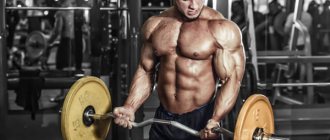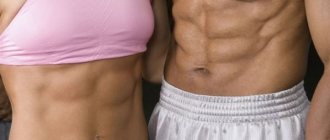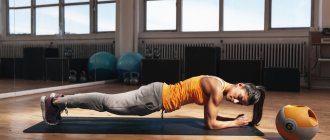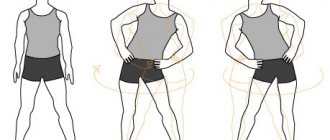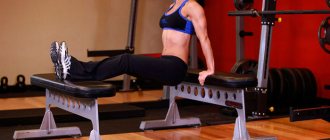Why a kettlebell?
The first question I ask a kettlebell training expert is: why kettlebell?
“Its advantage is that it is a projectile with a shifted center of gravity,” says Maria Larina. — For a dumbbell or barbell, it is located exactly in the center, but for a kettlebell it moves closer to the bottom, because there is a handle on top. This design allows the weight, unlike other projectiles, to seem to fly.” What's the use of a flying weight? Maria explains: training with a kettlebell involves smooth and rotational movements that are impossible with dumbbells. You have to not only work with weight, but also control the force of inertia. This requires more effort and - what is important - the effort of the whole body, rather than a separate muscle group .
“Kettlebell exercises are almost never aimed at isolated muscles,” says Maria. - At first glance, it seems that the arms are mainly working, but most often they are only a conductor of energy, and it is actually the abs, hips or buttocks that are working.
Exercise 5: Mill
- Reps: 10 per side
- Approaches: 3
Starting position: Stand with your feet shoulder-width apart, holding a kettlebell in your right hand. Turn your left foot at an angle of 45 degrees. Swing the weight down between your legs, and on the reverse movement, pull it toward your shoulder. Keep your back straight. Straighten your elbow and lift the kettlebell up above your head.
Execution: without bending your arm with the weight and your back, rotate at the hip joints so as to lower your straight body to your left leg until it is parallel with the floor. With your free hand, reach towards your foot and look at the weight. Stay in this position for a few seconds, then use your core muscles to return your body to the starting position.
Repeat on the other side.
The mill is a fairly difficult exercise.
Arms are perpendicular to the floor, back straight.
The effect of training with a kettlebell
Before talking with Maria, I had already tried an exercise with a kettlebell once - at a CrossFit . It was the so-called swing: we squatted, swung the kettlebell between our legs, and then stood up and pushed it forward to chest level. I easily completed just two sets of 10 reps, but my hips and buttocks hurt for several days.
“Don’t be afraid to lift weights, you’ll love it! - says Maria. — First of all, I appeal to women. It has always been believed that training with kettlebells is a man's domain, but this is not at all true. Try it - and the results will pleasantly surprise you!”
All workouts are quite short, but very effective. Classes combine strength training and intense fat burning. Studies have shown that in just 20 minutes of exercise you spend 230-250 kilocalories .
Exercise 1: Swing
- Reps: 16-20
- Approaches: 3-4
Starting position: stand straight, feet shoulder-width apart. Hold the kettlebell in front with your arms extended downwards.
Execution: Bend your knees slightly and drive your hips back, swinging the kettlebell between your legs. Move your hips in the opposite direction and, straightening your knees, bring your arms straight with the weight to eye level. Keep your back straight throughout the movement and your shoulders back.
The swing is the first kettlebell exercise.
Raise the weight to eye level.
Who invented training with kettlebells?
All these features were noted in the late 90s by a former Soviet soldier, and now a consultant to the US Marine Corps and famous fitness instructor Pavel Tsatsouline . He began to develop kettlebell fitness in the USA: he took exercises from kettlebell lifting as a basis and came up with new ones in addition to them. Over the course of ten years, this movement quickly gained popularity, and now in the States there is already a system of certification of kettlebell fitness trainers, and Tsatsouline, as the founder of the discipline, all weightlifters simply call Pavel and are happy to get a photo with his handshake.
In Russia, the birthplace of kettlebell lifting, kettlebell fitness is just beginning to penetrate. Only a couple of fitness clubs develop it, and exercises with weights are also used in CrossFit training. But thanks to activists like Maria Larina, the situation can change very soon.
How to do the workout
The workout includes four exercises with weights:
- Sumo Squats (18-22) – 2 rounds.
- Kettlebell swings (16–22) – 2 rounds.
- Clean and press (10-22) - 2 rounds.
- Deadlift sumo (16–22) – 2 rounds.
The weight with which the movements were performed in the study is indicated in parentheses. But since these were athletic men 20–23 years old with experience in strength training, you shouldn’t get hung up on these numbers: select the weight to suit your level of training.
Perform the first exercise for 20 seconds, then rest for 10 seconds and repeat the same thing again. This way the sumo squat will take you 1 minute.
Next, move on to kettlebell swings, do them exactly the same way - in the 20/10 format, two rounds. Perform all the movements on the list in this way and start over.
In total you need to complete three circles, one is shown in the video.
Equipment for training with kettlebells
If you have no training experience at all, Maria recommends starting to train with a 5-6 kg weight and increasing the weight to 8 kg as soon as possible. Those who are already confident in lifting weights need to start with 12 kg .
You can do kettlebell fitness in any comfortable sportswear, but there are special requirements for shoes. It's better not to have it at all. If working out barefoot is uncomfortable, then wear sneakers or flat-soled sneakers, as shock-absorbing running shoes will not work. When training with kettlebells, it is important to stand very firmly on the floor and feel the support in your heels. If the heel is raised, the center of gravity will shift forward, the exercise technique will be disrupted, and the load will be removed from the target muscles. For example, if the hamstring muscles are shortened, they will produce less work needed.
Am I not over pumping?
This is impossible. If the word “weight” makes you think of female weightlifters, immediately throw these associations out of your head. Those athletes who squat with huge weights were not originally skinny. For weightlifting, you must have innate inclinations: what they like to call “wide bones.”
By training with a kettlebell, you force your body to work on endurance through high-intensity exercise. Therefore, you will not have any fat left over the pumped muscles.
CONTRAINDICATIONS:
problems with joints, knees; lower back pain; problems with the spine; injuries to the shoulders and wrists.
How to choose the weight of the projectile
Girls with experience in strength training can start training with a 12, 16, 18 or 24 kg kettlebell, depending on their level of training. For beginners there is a lighter option - 8 kg.
If you don't know what weight to choose to start with, try doing the exercise with a kettlebell 10-15 times. If you can do this and you can do more, feel free to take the selected weight. No - you need to start with something easier.
WHAT TO BRING TO TRAINING:
Magnesia. This is a special powder or liquid to prevent your palms from sweating during training and the weight from slipping out of your hands. It is not advisable to practice while wearing gloves.
Comfortable sportswear.
Shoes with stable hard soles.
Belt - optional. It is better to choose not leather, like those worn by weightlifters, but soft, supportive ones.
Kettlebell exercises for women: a beautiful body in 20 minutes a day!
1. Kettlebell rotation
Warm-up exercise. Take the weight with both hands, place your feet shoulder-width apart, open your shoulders. Rotate the kettlebell around yourself, grabbing it with your other hand in front of you and behind your back. You can put your feet together and then you will increase the load on the buttocks. Rotate the kettlebell for 30 seconds in each direction.
2. Swing with two hands
Exercise for the muscles of the legs (emphasis on the back of the thigh) and buttocks, as well as for developing endurance. Stand with your feet slightly wider than shoulder-width apart, rest your weight on your heels, and place the kettlebell slightly in front of you. Push your hips back (like a deadlift) until you can comfortably grasp the kettlebell. Don't intentionally bend your knees - they should bend slightly following the movement of your hips. Maintaining the natural arch of your back, grasp the kettlebell with both hands. Swing the kettlebell between your legs, and then straighten your legs and body with a jerking motion. The weight should pass forward and upward between your legs and stop at chest level. Do not make any effort with your arms - the movement should occur through a jerk of your hips. Without slowing down, repeat the swing between your legs. Focus on sharply straightening your hips, tightening your abs and buttocks. Perform 15 repetitions.
3. Belt pull
Exercise for the back muscles. Grasp the kettlebell with one hand and step forward into a shallow lunge with your opposite leg. Place your free hand on your leg. Pull the kettlebell towards you, moving your elbow back. Keep your shoulders turned, your abs tense, and maintain the natural arch of your back. Perform 10 repetitions.
4. Repeat the swing
5. Repeat the row with your right hand.
6. Repeat the swing.
7. Standing press (“military press”)
Exercise for triceps and deltoid muscles. Bend your arm and lift the weight toward your shoulder. Hold the kettlebell without bending your wrist. Lower your free hand down, transfer your body weight to your heels. Press the weight upward until your arm is fully extended. In the upper position, turn your hand away from you, pointing your palm forward. Maintain tension in the muscles of the abs, buttocks and back. Pull your arm straight up, without leaning forward, so that there is no tilt in the shoulder joint. Perform one approach with only your left hand: with a weight of 4-5 kg - 10 repetitions, with a weight of 8 kg - 5 repetitions.
8. Repeat the swing.
9. Repeat the standing press with your right arm.
10. Repeat the swing.
11. Hot potatoes
Exercise for the abdominal muscles. Place your feet slightly wider than your shoulders and hold the weight in your hands upside down. Bend your arms and slowly transfer the weight from one hand to the other, holding it at approximately shoulder level. At the initial stage, the distance between the hands should be no more than 5 cm. Over time, you can increase both the distance and the speed of shifting. Be sure to keep your abdominal muscles tense. Perform for 1 minute.
12. Repeat the swing.
13. Repeat rotating the weights for 30 seconds in both directions.
14. Perform the final swing.
After completing the exercises, walk a little at a calm pace, then do stretching exercises for the muscles of the whole body.
Exercise 2: Squats
- Reps: 10-12
- Approaches: 3-4
Starting position: Place your feet slightly wider than shoulder width. Grab two moderately heavy weights so that your hands are in an outward position (as shown). Keep your elbows close to your body and hold the weights at shoulder level.
Execution: Maintaining the position of your hands with weights, move your hips back and do a squat. You need to squat as low as you can, keeping your back straight with a slight arch at the bottom. Point your elbows straight down. Press your heels into the floor, and try to keep your knees level with your toes.
Weighted squats are great for training your glutes.
Keep your back straight.
What does the exercise do?
Like other types of squats, kettlebell squats develop the muscles of the lower body. First of all, these are the quadriceps (front of the thigh). The gluteus maximus muscles also work. Additional stress is experienced by the muscle group of the posterior thigh, calf muscles, and lower back. Due to the fact that you hold a weight in your hands, your biceps and shoulders experience static tension. In other words, the array of muscle groups involved is quite large.
Performing goblet squats effectively works the muscles of the legs and buttocks.
In addition to training the hips and buttocks, the exercise has the following positive effects:
- To perform the exercise correctly, you need to work on hip mobility and flexibility and lower back stability. The ability not to twist the tailbone forward when performing squats is an important quality for an athlete.
- A large range of motion gives a good stretch to the muscles of the thighs and buttocks. And the more a muscle stretches before it contracts, the more effective its training.
- Improving blood circulation in the pelvic organs, preventing congestion.
Please note that if you have not previously been involved in fitness, and the muscles of your legs, buttocks and back are not sufficiently developed, when performing deep squats, you expose significant stress to the knee ligaments, which can lead to injury. Therefore, if you are just starting your training, limit yourself to regular squats until your thighs are parallel to the floor. Also, people with lower back pain should not tempt fate. Otherwise, goblet squats are a fairly safe exercise, provided you follow the technique.



